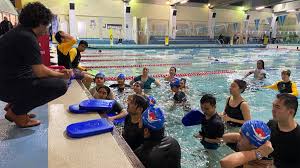Every Australian has a water story. From swimming lessons at the local pool to coastal holidays and backyard summer fun, water is part of daily life. But with that familiarity comes risk—and a need for smart, preventative action.
Water safety isn’t just for professionals. Whether you’re supervising kids at the pool, heading out on a boat, or planning a school excursion, there are practical ways everyone can reduce risk and create safer environments.
So, what are the three ways to keep water safe? These simple principles are taught in every water safety course and form the backbone of every safe swimming, teaching, or recreational experience.
1. Supervise Actively—Every Time
It only takes seconds for a fun swim to become a life-threatening emergency. Drowning is fast, silent, and often happens in water just a few centimetres deep. That’s why active supervision is the single most effective way to prevent accidents—especially with children.
Active supervision means:
- Staying within arm’s reach of young children
- Watching continuously—no phones, no distractions
- Appointing a designated watcher at gatherings
- Knowing what to do in an emergency and being ready to respond
Even with experienced swimmers, supervision matters. Teenagers and adults are still vulnerable to fatigue, cramps, or sudden medical issues in the water.
Supervision is a core skill in every water safety course because it doesn’t rely on equipment or complex knowledge—just presence, awareness, and preparedness.
✅ Pro Tip: At barbecues or pool parties, take turns being the official “watcher” and make sure everyone knows who’s on duty. This avoids the common problem where everyone assumes “someone else” is watching.
2. Make the Environment Safe and Predictable
Safe water doesn’t start with swimming—it starts with the environment. Whether you’re in a backyard pool, a river, or a school facility, your surroundings must support safe behaviour and quick response.
Key actions include:
- Fencing pools with compliant barriers and child-proof gates
- Removing hazards like floatable toys, chairs near pool edges, or tripping risks
- Checking depth before diving or jumping
- Reading warning signs at beaches, rivers, or dams
- Providing rescue equipment nearby, such as a reach pole or flotation aid
In a teaching or group setting, clearly marking deep water, using lane ropes, and maintaining orderly access points also reduces confusion and crowding.
A properly set-up environment helps prevent accidents before they happen and gives supervisors time to step in when needed.
According to Royal Life Saving Australia, compliant pool fencing alone could prevent 50% of child drownings in backyard settings.
3. Educate and Practise Water Safety Skills
The most effective long-term strategy? Teach everyone—from toddlers to teens to adults—what to do in and around water. Knowledge builds confidence and reduces panic during emergencies.
This includes:
- Learning to float, tread water, and call for help
- Understanding rip currents and how to escape them
- Knowing how to use basic rescue techniques (like reach and throw)
- Teaching the importance of swimming with a buddy
- Building awareness of how water conditions can change
- Knowing basic CPR and emergency response steps
A structured water safety course introduces these skills in a progressive, hands-on way. It doesn’t just cover how to swim—it teaches how to supervise, communicate, plan, and react.
Whether you’re a parent, educator, or community leader, passing this knowledge on can create a ripple effect of safer choices and lifesaving decisions.
Real-World Example: Three Layers of Protection in Action
Emma, a teacher from Ballarat, was supervising a Year 5 school swimming carnival at a public pool. Before the event:
- She checked all fences, entry points, and signage
- Organised staff-to-student ratios and designated lookout points
- Briefed students on water rules and how to get help
- Ensured rescue equipment was visible and available
- Had her own CPR certification refreshed through a water safety course
During the event, one student froze mid-swim. A lifeguard noticed early and helped him to the edge before distress set in. There was no panic. No delay. No injury. That layered preparation—from physical setup, to supervision, to safety skills—made all the difference.
Who Needs to Know These Three Rules?
Everyone.
Whether you’re:
- A parent supervising your kids in a blow-up backyard pool
- A school staff member leading an excursion
- A coach running swim squad
- A lifesaver keeping watch at the beach
- Or simply someone who enjoys kayaking, fishing, or swimming in nature
…these three strategies are your toolkit for keeping water safe.
And if you’re thinking about teaching swimming or helping others build these skills, enrolling in a certified course ensures you’re equipped to lead with confidence and credibility.
Final Thoughts
So—what are the three ways to keep water safe?
- Supervise actively.
- Create safe environments.
- Teach and practise water safety skills.
It’s not about being a hero. It’s about being ready. These three layers work together to reduce risk, promote confidence, and keep water a space for enjoyment—not tragedy.
Whether you’re learning for yourself or preparing to teach others, it all starts with structured, accessible education. A certified water safety course gives you the knowledge and tools to make the right call when it matters most.

